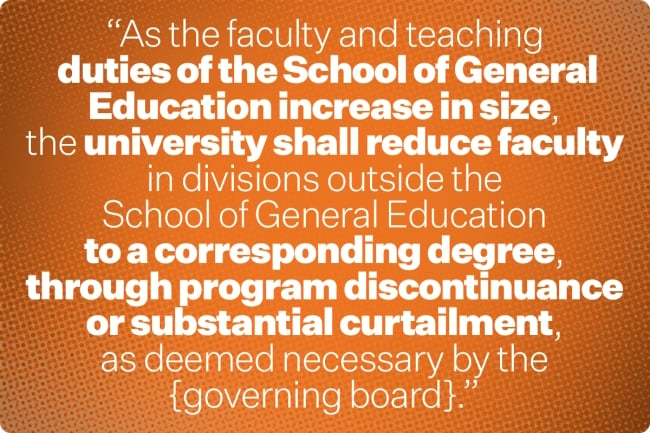You have /5 articles left.
Sign up for a free account or log in.

Photo illustration by Justin Morrison/Inside Higher Ed
Today, conservative activists will launch a public campaign to enact new model legislation called the General Education Act. Behind this bland name is a proposal for the most radical assault on faculty and academic freedom in American history. If the model legislation were to be enacted, lawmakers would force public colleges to adopt a uniform general education curriculum devoted to conservative values, give a new dean near-total power to hire all faculty to teach these classes and then require the firing of many existing faculty members in the humanities and social sciences, including tenured professors.
The GEA’s extreme ideas are not the babblings of some obscure blogger. They are a joint proposal from three leading conservative groups—the Ethics and Public Policy Center, the James G. Martin Center for Academic Renewal, and the National Association of Scholars. One lead author, Stanley Kurtz, has an extensive track record of writing legislation aimed at suppressing liberal ideas in education. His 2021 Partisanship Out of Civics Act has been copied by state legislators seeking to ban critical race theory. A profile of Kurtz in The Guardian called him “the conservative scholar who lit a match to the U.S. right’s education wars.”
The GEA represents a dire threat to academic values. First, it imposes an entirely new general education curriculum on public colleges without any faculty input. It would compel students to take 42 credit hours, or 13 specific courses, with almost no options. These courses would account for more than one-third of college coursework in a typical bachelor’s degree (bachelor of science students would be exempted from some of the humanities requirements and would need 10 total general education courses).
Secondly, the GEA dictates a right-wing (“in the classic Western liberal arts tradition”) curriculum terrified of any contemporary ideas and devoted to excluding them. The rhetoric class focuses on Aristotle, Cicero and Hugh Blair. The sole U.S. history course ends in 1877. The only U.S. literature course, explicitly devoted to “great books,” stops at 1914. The Western humanities courses only go up to 1950. Western History II is graciously permitted to reach the year 2000 so that the fall of the Soviet Union can be included. Ideas from the past century are largely omitted except in the required economics class.
This curriculum reform is an appalling idea, with the most massive (and awful) general education transformation ever contemplated simply being imposed by legislative fiat. But as terrible as this plan is, the other provisions of the GEA are even more alarming.
The act would also destroy shared governance and remove faculty influence from any part of the faculty hiring process, giving the dean of a new School of General Education sole power to appoint all faculty and staff members (with approval from the president and trustees) charged with delivering this new curriculum. This is a recipe for total politicization of the faculty hiring process at colleges, replacing academic merit with submission to the whims of one dean.
The dictatorial power of this dean goes far beyond faculty hiring to encompass massive authority over graduate students across the entire university: “The dean may offer teaching and research positions, stipends, fellowships, awards, and any other form of remuneration to graduate students in any academic unit.” All these funds for graduate students would be limited to one year, “renewable at the dean’s discretion.”
The act dictates that the new School of General Education “shall be granted authority to offer courses and develop certificate, minor, and major programs as well as graduate programs, and offer degrees.” This proposed school is not a shadow university; it’s a substitute university, capable of creating an exact duplicate of the existing university with its own majors and graduate programs.
The authors of the GEA acknowledge the difficulty in giving one dean dictatorial power to achieve their totalitarian transformation of higher education. They advise having a Board of Trustees that “rapidly installs a president fully committed to traditional general education,” who can appoint a proper dean, and urge extensive legislative oversight to make sure the political purge is “faithfully” carried out.
The right-wing curriculum and the dictatorial dean are more than sufficient reasons to reject this awful model legislation. But the worst aspect of the GEA is the massive purge of existing faculty it plans to accomplish through this transformation of the university.
Incredibly, the GEA would legally compel colleges to fire one existing professor for every professor hired to teach in the new right-wing school: “As the faculty and teaching duties of the School of General Education increase in size, the university shall reduce faculty in divisions outside the School of General Education to a corresponding degree, through program discontinuance or substantial curtailment.” The result of this “model” act could be the largest political purge of faculty in the history of the world.
This is not my nightmarish imagination concocting a scenario of mass firings. It’s the whole goal of the GEA, to transform not merely the entire college curriculum but also the faculty who teach it. Peter Berkowitz, the Tad and Dianne Taube Senior Fellow at the Hoover Institution, calls the GEA “the most ambitious legislative proposal for higher education reform in living memory,” praising its goal of “fully or partially closing programs and departments, discharging faculty, and discontinuing tenure lines.”
As GEA co-author Kurtz puts it, “quite a few new faculty will need to be hired. Existing faculty are eligible for joint appointment in the School of General Education, but such appointments are temporary and at the sole discretion of the school’s dean.” And any new hires, Kurtz writes, “will put the university under unsustainable financial stress unless it dismisses an equivalent number of existing faculty. This could require the closure of entire programs or departments, and the dismissal of even tenured faculty.”
Kurtz claims, “Academic freedom does not prevent this. On the contrary, department closures under these circumstances are consistent with the American Association of University Professors’ policy on ‘program discontinuance,’ which permits the elimination of entire programs, and the dismissal of even tenured faculty, when that is occasioned by a fundamental change in the university’s ‘educational mission.’”
This is completely false. The AAUP guidelines require that any program discontinuance be “determined primarily by the faculty” and state that a university must “make every effort” to place an affected professor in another position. No one who believes in academic freedom could ever imagine that it is legitimate for legislators to impose an entirely new faculty chosen for their political viewpoints and then fire the existing tenured professors who teach the same subjects.
Kurtz eventually more or less admits that this plan violates AAUP standards because it compels dismissals even when a program is not discontinued: “Rather than restricting reduction of existing faculty to the shuttering of entire departments, the General Education Act allows for ‘substantial curtailment’ of a program or department,” which Kurtz praises because it “provides greater scope and flexibility for faculty dismissals.” In other words, Kurtz thinks a key virtue of this act is that it allows public colleges to keep an English major while firing most of the English professors who are too left-wing and replacing them with conservatives.
Kurtz reveals that the purpose of the GEA is primarily ideological transformation: “The School of General Education is likely to bring more conservatives and traditional liberals” to the university, and they would replace existing left-wing faculty, who will be fired. I am not reassured by Kurtz’s assertion that “faculty reductions notwithstanding, plenty of critical theory–oriented faculty are sure to remain on campus,” as if a partial purge of leftist professors will create “a robust marketplace of ideas.”
The GEA reflects a growing conservative movement to suppress academic freedom and impose legislative control on higher education, and the attacks on academia in Republican states make passage of state-level bills modeled on the GEA a realistic threat. And if Donald Trump wins the presidency in 2024 with a Republican Congress, it’s easy to imagine the GEA becoming a model for national legislation aimed at wiping out left-wing faculty.
Regardless of our criticisms of academia, I hope that all of us—leftists, liberals, centrists and conservatives alike—can unite to oppose a terrible plan for a total legislative takeover of public higher education that would impose a narrow-minded curriculum, destroy academic hiring standards, crush tenure, eliminate shared governance and attack academic freedom at its foundations.








